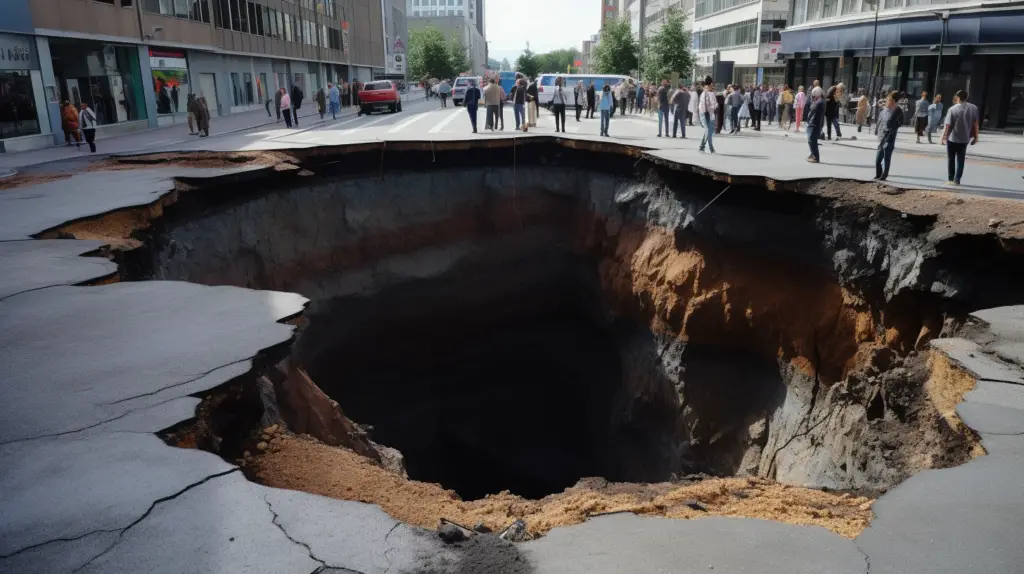Sinkholes are sudden, terrifying holes that can open up in the earth without warning. Though they can be deadly and destructive, they are also fascinating geological phenomena that have much to teach us about the earth and its processes. From their causes to their impacts, from the most famous sinkholes to methods of prediction and prevention.
This article aims to share 25 essential facts about sinkholes. Let’s delve into the unknown depths and illuminate the mysteries of these earth-gobbling wonders.
1. Definition: A sinkhole is a depression or hole in the ground caused by some form of collapse of the surface layer. They can vary in size from just a few feet in diameter to large enough to swallow entire buildings.
2. Causes: Sinkholes most often occur in areas with bedrock composed of limestone, salt beds, or other carbonate rocks that are soluble in groundwater. The dissolution of the rock creates underground cavities. When the roof of one of these cavities collapses, a sinkhole forms.
3. Natural Sinkholes: Sinkholes can form naturally over thousands of years as rainwater and groundwater gradually dissolve bedrock and carry it away.
4. Human-Induced Sinkholes: Sinkholes can also be caused by human activities such as over-extraction of groundwater, industrial operations, mining activities, or heavy traffic loads on the surface.
5. Classification: There are three main types of sinkholes: dissolution sinkholes, cover-subsidence sinkholes, and cover-collapse sinkholes. The type depends on the mechanism of formation and the nature of the surface material.
6. Speed of Formation: While some sinkholes form gradually over time, others appear suddenly in a process called a “collapse sinkhole”. These can form within minutes to hours.
7. Size: Sinkholes can vary in size, ranging from a few feet across to hundreds of acres. They can also be shallow or several hundred feet deep.
8. Dead Sea Sinkholes: Over 6,000 sinkholes have appeared around the Dead Sea since the 1980s due to the rapid decrease in the sea level. This is the highest concentration of sinkholes in the world.
9. Florida Sinkholes: Florida is notorious for sinkholes because the state’s bedrock is largely made up of limestone. Florida law even requires home insurers to offer coverage for damage caused by sinkholes.
10. Largest Sinkhole: The largest sinkhole in the world is in China, named the Xiaozhai Tiankeng. It’s 662 meters deep and 626 meters wide.
READ MORE: 25 Important Facts You Need to Understand About Earthquakes
11. Deadly Sinkholes: Sinkholes have been known to cause fatalities. In 2013, a man in Florida died when a sinkhole opened under his bedroom while he was sleeping.
12. Impact on Property Value: The presence of sinkholes can greatly decrease the value of properties in the area due to the perceived risk.
13. Detection: Geologists use a variety of methods to detect potential sinkholes, including ground-penetrating radar and electrical resistivity imaging.
14. Prevention: Although it’s impossible to completely prevent sinkholes, managing water drainage and avoiding activities that destabilize the ground can reduce the risk.
15. Sinkholes as Ecosystems: Some sinkholes form unique ecosystems, with plant and animal species that are adapted to the specific conditions inside the sinkhole.
16. Sinkholes in Urban Areas: Sinkholes that open in urban areas can lead to significant property damage and pose serious safety hazards.
17. Famous Sinkholes: The Great Blue Hole in Belize is a famous underwater sinkhole that is a popular diving spot. It’s over 300 meters across and 125 meters deep.
18. Environmental Impact: Sinkholes can cause environmental damage by disrupting groundwater flow and causing surface water to drain into the aquifer.
19. Sinkhole Rehabilitation: Sinkholes can sometimes be rehabilitated by filling them in with concrete, soil, or other material. However, this can sometimes lead to further destabilization.
20. Cultural Significance: Sinkholes have cultural significance in some societies. For instance, the Mayans considered sinkholes, or cenotes, to be sacred portals to the underworld.
READ MORE: 25 Facts You Need to Understand About Heat Waves
21. Sinkholes and Climate Change: Some research suggests that climate change could lead to an increase in sinkhole formation due to changes in rainfall patterns and sea levels.
22. Carbon Sink: Sinkholes can act as carbon sinks, absorbing CO2 from the atmosphere as the carbonic acid that forms in the water dissolves rock.
23. Economic Impact: The economic cost of sinkholes in the US alone is estimated to be at least $300 million annually.
24. Insurance: Sinkhole damage is not typically covered by standard homeowners’ insurance policies. However, in some states, like Florida, insurance companies are required to offer sinkhole coverage.
25. Future Research: There’s still much to learn about sinkholes. Future research may enable us to better predict sinkhole formation and mitigate their impact.
READ MORE: 25 Facts You Need to Understand About Flash Floods
Sinkholes, these geological phenomena that both fascinate and frighten, serve as a stark reminder of the dynamic nature of Earth. Understanding them not only helps us manage the risks associated with their occurrence but also deepens our knowledge about our planet’s geological processes.


